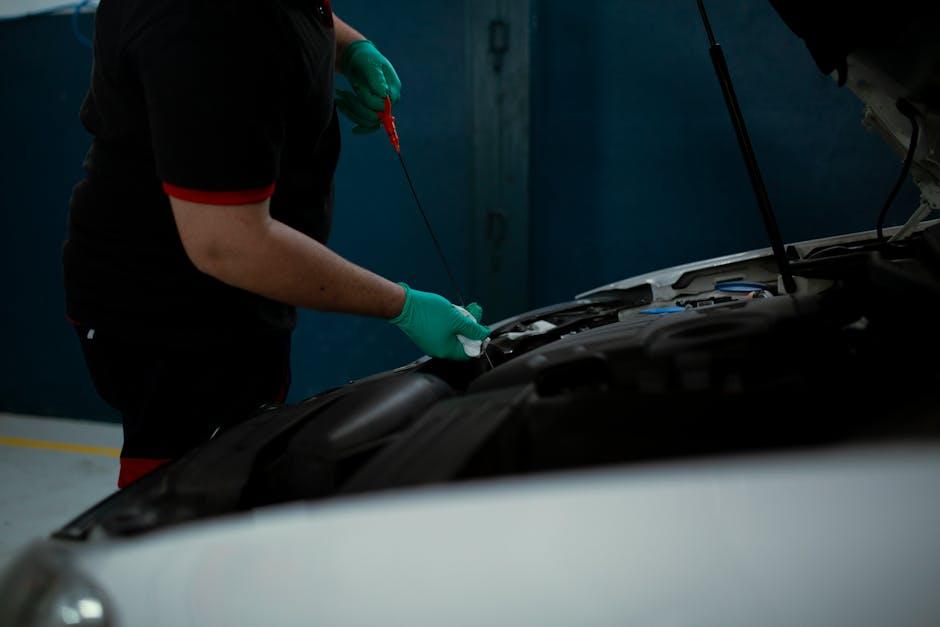Imagine slipping into the driver’s seat, turning the key, and hearing your engine hum to life—ready to take you anywhere. But beneath that smooth start lies a simple ritual that can save your vehicle from unexpected breakdowns: checking your oil level. While it might seem like a mundane task, knowing how to read an oil dipstick properly is an essential skill for every car owner. This modest tool offers a clear glimpse into the health of your engine, revealing whether it’s running smoothly or crying out for maintenance. In this guide, we’ll walk you through the steps to master the dipstick, turning a quick check into a powerful habit that keeps your car running at its best.
Table of Contents
- Understanding the Purpose of the Oil Dipstick
- Preparing Your Vehicle for an Accurate Reading
- Step-by-Step Guide to Removing and Cleaning the Dipstick
- Interpreting Oil Levels and Assessing Oil Quality
- Common Mistakes to Avoid When Checking Oil
- Tips for Maintaining Optimal Engine Health Through Regular Checks
- Q&A
- Key Takeaways

Understanding the Purpose of the Oil Dipstick
At the heart of vehicle maintenance lies a simple yet indispensable tool—the oil dipstick. Its primary role is to give you a direct glimpse into the state of your engine’s oil, which is vital for keeping your motor running smoothly. By sliding the dipstick into the oil reservoir and then pulling it out, you can visually inspect the oil’s level and condition, helping you catch potential engine troubles before they escalate. A properly maintained oil level ensures efficient lubrication, prevents engine wear, and supports overall vehicle health.
Key benefits of the oil dipstick include:
- Immediate oil level measurement
- Quick assessment of oil quality and cleanliness
- Early detection of contamination or oil degradation
- Cost-effective preventative maintenance tool
| Oil Indicator | Meaning | Action Required |
|---|---|---|
| Low Level | Oil below the minimum mark | Add oil immediately |
| Optimal Level | Oil between min & max marks | No action needed |
| Dirty Oil | Dark or gritty oil on dipstick | Schedule oil change soon |

Preparing Your Vehicle for an Accurate Reading
Before you get under the hood, it’s essential to ensure your vehicle is in the right condition for an accurate oil level check. Begin by parking on a level surface – an uneven ground can cause oil to pool unevenly, leading to misleading readings. For the most reliable result, it’s best to wait until the engine has been off for about 5 to 10 minutes. This brief pause gives the oil time to settle back into the pan, rather than clinging to engine parts or the dipstick tube.
Next, double-check that your vehicle’s hood is clean along the dipstick area to prevent dirt from contaminating the oil sample. When handling the dipstick, remember these useful points:
- Use a clean, lint-free cloth or paper towel to wipe the dipstick before reinserting it.
- Fully reinsert the dipstick to get an accurate oil level measurement.
- Keep the dipstick straight when pulling it out to avoid dripping or smearing the oil.
| Step | Tip |
|---|---|
| 1 | Park on flat ground |
| 2 | Wait 5-10 minutes after engine off |
| 3 | Wipe dipstick clean before use |
| 4 | Insert dipstick fully and steadily |

Step-by-Step Guide to Removing and Cleaning the Dipstick
Begin by locating the dipstick, which is usually marked with a bright handle — often yellow or orange — to ensure easy identification within the engine bay. With the engine turned off and cool, gently pull the dipstick out, taking care to hold it horizontally to avoid knocking oil off the tip. Use a clean, lint-free cloth or paper towel to thoroughly wipe the metal strip. This step is crucial for obtaining an accurate reading once reinserted.
After wiping, insert the dipstick fully back into its tube, ensuring it seats all the way in to avoid misreading the oil level. Pull it out again carefully, holding it horizontally this time, and observe the oil marks. The dipstick typically has two indicators — a minimum and a maximum line — which represent the acceptable oil range. Be sure to examine the oil’s color and texture as well; clean oil is usually amber and transparent, while darker, gritty oil suggests it’s time for a change.

Interpreting Oil Levels and Assessing Oil Quality
Knowing how to properly gauge your engine’s oil level is crucial for maintaining its health and optimizing performance. When you pull out the dipstick, look for the clear markers: the oil should ideally sit between the minimum and maximum indicators. If the oil level is below the minimum mark, it’s a red flag signaling the need to add more oil immediately to protect your engine from damage. Conversely, overfilled oil can cause pressure issues and leaks, so ensure the level isn’t surpassing the maximum line either. Keep your car on a level surface and the engine cool for the most accurate reading.
The color and texture of the oil on the dipstick also tell a story about its condition. Fresh oil typically appears translucent amber with a smooth consistency. If you notice the oil looks dark and gritty, this suggests contaminants have built up, and it might be time for an oil change. Additionally, a milky or frothy appearance can indicate coolant leaking into the oil, a serious issue requiring professional attention. Here’s a quick guide to help you assess oil quality visually:
| Oil Appearance | Possible Meaning | Recommended Action |
|---|---|---|
| Clear amber | Healthy, fresh oil | No immediate action needed |
| Dark brown/black | Old, contaminated oil | Schedule an oil change |
| Milky or frothy | Coolant mixed with oil | Consult a mechanic immediately |
| Thick and gritty | Excess dirt and debris | Oil replacement required |

Common Mistakes to Avoid When Checking Oil
One of the most frequent errors car owners make is checking the oil immediately after the engine has been running. Hot oil sticks to the walls of the engine and doesn’t give an accurate reading on the dipstick. It’s best to wait at least 10-15 minutes after turning off the engine to allow the oil to settle. Another pitfall is not wiping the dipstick clean before reinserting it. Residual oil from the previous reading can cause confusion, making it hard to determine the true oil level and condition.
Additionally, many overlook the importance of using the correct dipstick for their vehicle. Using a dipstick from a different model can lead to misleading results. Pay attention to the marks on the dipstick; some have lines, while others use holes or crosshatches to indicate the ideal level. To help remember the proper procedure, here’s a quick checklist:
- Park your car on a level surface.
- Turn off the engine and wait 10-15 minutes.
- Remove dipstick and wipe it clean with a lint-free cloth.
- Reinsert the dipstick fully and then pull it out again for your reading.
| Common Mistake | Effect | How to Avoid |
|---|---|---|
| Checking oil when engine is hot | Inaccurate oil level reading | Wait 10-15 minutes after engine off |
| Not wiping dipstick before checking | Oil level appears higher or unclear | Always clean dipstick before reinsertion |
| Using wrong dipstick for vehicle | Misleading or incorrect readings | Verify dipstick matches your car model |

Tips for Maintaining Optimal Engine Health Through Regular Checks
Keeping your engine in top shape often starts with routine inspections that can catch minor issues before they become costly repairs. One of the most straightforward yet crucial maintenance habits is regularly checking your oil level and condition. When done correctly, this quick check offers vital clues about your engine’s health and can help you spot potential problems like leaks, contamination, or insufficient lubrication.
To get the most accurate reading, ensure the vehicle is parked on a level surface and the engine is cool or has been off for several minutes. Pull out the dipstick slowly, wipe it clean with a lint-free cloth, then reinsert it fully before pulling it out again. Look closely at the oil level relative to the marked indicators, and inspect the color and texture. Healthy oil will be a clear amber shade. Keep in mind these critical checks:
- Oil Level: Should fall between the minimum and maximum marks.
- Color & Consistency: Avoid oil that is dark black, gritty, or milky.
- Smell: A burnt odor can indicate overheating or engine trouble.
- Top up or change oil if needed.
- Schedule a professional inspection if abnormalities are found.
| Oil Indicator | What It Means | Recommended Action |
|---|---|---|
| Below Minimum | Low oil level | Top up oil immediately |
| Between Marks | Optimal oil level | Maintain regular checks |
| Black & Gritty | Contaminated oil | Change oil urgently |
| Milky | Possible coolant leak | Consult mechanic |
Q&A
Q: What is the purpose of an oil dipstick?
A: An oil dipstick is a simple yet vital tool that helps you check the engine oil level and its condition, ensuring your vehicle runs smoothly and avoids engine damage.
Q: When is the best time to check the oil level with a dipstick?
A: For the most accurate reading, check your oil when the engine is warm but turned off for a few minutes, allowing the oil to settle back into the pan.
Q: How do I locate the dipstick in my vehicle?
A: Look for a small, usually brightly colored handle marked with an oil can icon, typically located near the engine block.
Q: What’s the proper way to use the dipstick?
A: First, pull the dipstick out slowly, wipe it clean with a lint-free cloth, reinsert it fully, then pull it out again to read the oil level.
Q: How do I interpret the oil level on the dipstick?
A: Check where the oil film ends between the “min” and “max” marks. The oil should be closer to the “max” line but never above it. Below “min” means you need to add oil.
Q: What should I look for besides the oil level?
A: Observe the oil’s color and texture. Fresh oil is usually amber and translucent. Dark, gritty, or milky oil can indicate contamination or engine issues and may require a change or inspection.
Q: Can temperature affect the reading?
A: Yes. Checking when the oil is cold or right after turning off a hot engine can give inaccurate readings due to oil distribution, so it’s best to wait a few minutes after driving.
Q: How often should I check my oil with the dipstick?
A: It’s good practice to check your oil at least once a month or before long trips to maintain optimal engine health.
Q: What if the oil level is too low or too high?
A: Low oil can cause engine damage, so add oil slowly and recheck. Too much oil can cause foaming or leaks—if overfilled, you may need to drain some out.
Q: Is using the dipstick alone enough to maintain engine health?
A: While dipstick checks are essential, regular oil changes and professional inspections are also crucial for your engine’s longevity.
Key Takeaways
Mastering the art of reading your oil dipstick isn’t just a routine task—it’s a subtle conversation with your vehicle, a moment where you tune into its well-being. By regularly checking and understanding what the dipstick tells you, you empower yourself to catch potential issues early and keep your engine purring smoothly. So next time you pop the hood and pull out that trusty stick, remember: you’re not just measuring oil—you’re safeguarding the journey ahead.

